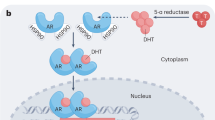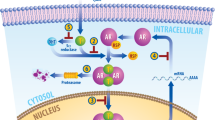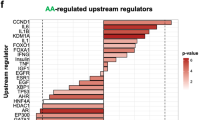Abstract
Antiandrogen therapy is an important modality in the treatment of prostate cancer. Recent research into the role of angiogenesis in tumour growth and metastasis has uncovered links between antiandrogen therapy, radiation therapy and angiogenesis, which have exciting implications for the treatment of prostate cancer. Angiogenic cytokines such as vascular endothelial growth factor (VEGF) have been identified in prostate cancer cells and tumours, and androgens appear to stimulate VEGF. This article assesses the antiangiogenic effects of hormonal therapy and assesses the role that angiogenesis may play in the observed cooperation between hormonal and radiation therapies for prostate cancer.
This is a preview of subscription content, access via your institution
Access options
Subscribe to this journal
Receive 4 print issues and online access
$259.00 per year
only $64.75 per issue
Buy this article
- Purchase on Springer Link
- Instant access to full article PDF
Prices may be subject to local taxes which are calculated during checkout

Similar content being viewed by others

References
Crawford ED . Epidemiology of prostate cancer. Urology 2003; 62 (6 Suppl 1): 3–12.
Jemal A et al. Cancer statistics, 2003. CA Cancer J Clin 2003; 53: 5–26.
Sosa M, Sanguineti G . External beam radiotherapy as definitive treatment for prostate cancer. Minerva Urol Nefrol 2003; 55: 263–275.
Cooperberg MR, Small EJ, D'Amico A, Carroll PR . The evolving role of androgen deprivation therapy in the management of prostate cancer. Minerva Urol Nefrol 2003; 55: 219–238.
Gottschalk AR, Roach M . The use of hormonal therapy with radiotherapy for prostate cancer: analysis of prospective randomised trials. Br J Cancer 2004; 90: 950–954.
Campbell CL, Savarese DM, Quesenberry PJ, Savarese TM . Expression of multiple angiogenic cytokines in cultured normal human prostate epithelial cells: predominance of vascular endothelial growth factor. Int J Cancer 1999; 80: 868–874.
Klagsbrun M, Soker S . VEGF/VPF: the angiogenesis factor found? Curr Biol 1993; 3: 699–702.
Claffey KP, Robinson GS . Regulation of VEGF/VPF expression in tumor cells: consequences for tumor growth and metastasis. Cancer Metastasis Rev 1996; 15: 165–176.
Joseph IB, Isaacs JT . Potentiation of the antiangiogenic ability of linomide by androgen ablation involves down-regulation of vascular endothelial growth factor in human androgen-responsive prostatic cancers. Cancer Res 1997; 57: 1054–1057.
Stewart RJ, Panigrahy D, Flynn E, Folkman J . Vascular endothelial growth factor expression and tumor angiogenesis are regulated by androgens in hormone responsive human prostate carcinoma: evidence for androgen dependent destabilization of vascular endothelial growth factor transcripts. J Urol 2001; 165: 688–693.
Fernandez A et al. Angiogenic potential of prostate carcinoma cells overexpressing bcl-2. J Natl Cancer Inst 2001; 93: 208–213.
Mabjeesh NJ et al. Androgens stimulate hypoxia-inducible factor 1 activation via autocrine loop of tyrosine kinase receptor/phosphatidylinositol 3′-kinase/protein kinase B in prostate cancer cells. Clin Cancer Res 2003; 9: 2416–2425.
Fukuda R, Kelly B, Semenza GL . Vascular endothelial growth factor gene expression in colon cancer cells exposed to prostaglandin E2 is mediated by hypoxia-inducible factor 1. Cancer Res 2003; 63: 2330–2334.
Fukumura D et al. Tumor induction of VEGF promoter activity in stromal cells. Cell 1998; 94: 715–725.
Folkman J . What is the evidence that tumors are angiogenesis dependent? J Natl Cancer Inst 1990; 82: 4–6.
Folkman J . Seminars in medicine of the Beth Israel Hospital, Boston. Clinical application of research on angiogenesis. N Engl J Med 1995; 333: 1757–1763.
Harris AL . Antiangiogenesis for cancer therapy. Lancet 1997; 349 (Suppl 2): SII13–SII15.
Thorpe PE . Vascular targeting agents as cancer therapeutics. Clin Cancer Res 2004; 10: 415–427.
Albo D, Wang TN, Tuszynski GP . Antiangiogenic therapy. Curr Pharm Des 2004; 10: 27–37.
Tortora G, Melisi D, Ciardiello F . Angiogenesis: a target for cancer therapy. Curr Pharm Des 2004; 10: 11–26.
Hashizume H et al. Openings between defective endothelial cells explain tumor vessel leakiness. Am J Pathol 2000; 156: 1363–1380.
Fox SB et al. Relationship of endothelial cell proliferation to tumor vascularity in human breast cancer. Cancer Res 1993; 53: 4161–4163.
Lissbrandt IF, Stattin P, Damber JE, Bergh A . Vascular density is a predictor of cancer-specific survival in prostatic carcinoma. Prostate 1997; 33: 38–45.
Weidner N, Sample JP, Welch WR, Folkman J . Tumor angiogenesis and metastasis—correlation in invasive breast carcinoma. N Engl J Med 1991; 324: 1–8.
Gettman MT et al. Prediction of patient outcome in pathologic stage T2 adenocarcinoma of the prostate: lack of significance for microvessel density analysis. Urology 1998; 51: 79–85.
Halvorsen OJ, Haukaas S, Hoisaeter PA, Akslen LA . Independent prognostic importance of microvessel density in clinically localized prostate cancer. Anticancer Res 2000; 20: 3791–3799.
Bono AV et al. Microvessel density in prostate carcinoma. Prostate Cancer Prostatic Dis 2002; 5: 123–127.
Silberman MA, Partin AW, Veltri RW, Epstein JI . Tumor angiogenesis correlates with progression after radical prostatectomy but not with pathologic stage in Gleason sum 5 to 7 adenocarcinoma of the prostate. Cancer 1997; 79: 772–779.
Duque JLF et al. Plasma levels of vascular endothelial growth factor are increased in patients with metastatic prostate cancer. Urology 1999; 54: 523–527.
Kohli M, Kaushal V, Spencer HJ, Mehta P . Prospective study of circulating angiogenic markers in prostate-specific antigen (PSA)-stable and PSA-progressive hormone-sensitive advanced prostate cancer. Urology 2003; 61: 765–769.
Borgstrom P et al. Neutralizing anti-vascular endothelial growth factor antibody completely inhibits angiogenesis and growth of human prostate carcinoma micro tumors in vivo. Prostate 1998; 35: 1–10.
Fox WD et al. Antibody to vascular endothelial growth factor slows growth of an androgen-independent xenograft model of prostate cancer. Clin Cancer Res 2002; 8: 3226–3231.
Franck-Lissbrant I et al. Testosterone stimulates angiogenesis and vascular regrowth in the ventral prostate in castrated adult rats. Endocrinology 1998; 139: 451–456.
Joseph IB, Nelson JB, Denmeade SR, Isaacs JT . Androgens regulate vascular endothelial growth factor content in normal and malignant prostatic tissue. Clin Cancer Res 1997; 3: 2507–2511.
Haggstrom S, Lissbrant IF, Bergh A, Damber JE . Testosterone induces vascular endothelial growth factor synthesis in the ventral prostate in castrated rats. J Urol 1999; 161: 1620–1625.
Benjamin LE et al. Selective ablation of immature blood vessels in established human tumors follows vascular endothelial growth factor withdrawal. J Clin Invest 1999; 103: 159–165.
Jain RK et al. Endothelial cell death, angiogenesis, and microvascular function after castration in an androgen-dependent tumor: role of vascular endothelial growth factor. Proc Natl Acad Sci USA 1998; 95: 10820–10825.
Lissbrant IF et al. Neutralizing VEGF bioactivity with a soluble chimeric VEGF-receptor protein flt(1-3)IgG inhibits testosterone-stimulated prostate growth in castrated mice. Prostate 2004; 58: 57–65.
Mazzucchelli R et al. Vascular endothelial growth factor expression and capillary architecture in high-grade PIN and prostate cancer in untreated and androgen-ablated patients. Prostate 2000; 45: 72–79.
Rak J, Yu JL, Kerbel RS, Coomber BL . What do oncogenic mutations have to do with angiogenesis/vascular dependence of tumors? Cancer Res 2002; 62: 1931–1934.
Movsas B et al. Hypoxic regions exist in human prostate carcinoma. Urology 1999; 53: 11–18.
Cvetkovic D et al. Increased hypoxia correlates with increased expression of the angiogenesis marker vascular endothelial growth factor in human prostate cancer. Urology 2001; 57: 821–825.
Kung AL et al. Suppression of tumor growth through disruption of hypoxia-inducible transcription. Nat Med 2000; 6: 1335–1340.
Shweiki D, Itin A, Soffer D, Keshet E . Vascular endothelial growth factor induced by hypoxia may mediate hypoxia-initiated angiogenesis. Nature 1992; 359: 843–845.
Wang GL, Jiang BH, Rue EA, Semenza GL . Hypoxia-inducible factor 1 is a basic-helix-loop-helix-PAS heterodimer regulated by cellular O2 tension. Proc Natl Acad Sci USA 1995; 92: 5510–5514.
Semenza GL . Targeting HIF-1 for cancer therapy. Nat Rev Cancer 2003; 3: 721–732.
Krishnamachary B et al. Regulation of colon carcinoma cell invasion by hypoxia-inducible factor 1. Cancer Res 2003; 63: 1138–1143.
Fukuda R et al. Insulin-like growth factor 1 induces hypoxia-inducible factor 1-mediated vascular endothelial growth factor expression, which is dependent on MAP kinase and phosphatidylinositol 3-kinase signaling in colon cancer cells. J Biol Chem 2002; 277: 38205–38211.
Maity A et al. Epidermal growth factor receptor transcriptionally up-regulates vascular endothelial growth factor expression in human glioblastoma cells via a pathway involving phosphatidylinositol 3′-kinase and distinct from that induced by hypoxia. Cancer Res 2000; 60: 5879–5886.
Zhong H, Semenza GL, Simons JW, De Marzo AM . Up-regulation of hypoxia-inducible factor 1alpha is an early event in prostate carcinogenesis. Cancer Detect Prev 2004; 28: 88–93.
Wachsberger P, Burd R, Dicker AP . Tumor response to ionizing radiation combined with antiangiogenesis or vascular targeting agents: exploring mechanisms of interaction. Clin Cancer Res 2003; 9: 1957–1971.
Zietman AL, Nakfoor BM, Prince EA, Gerweck LE . The effect of androgen deprivation and radiation therapy on an androgen-sensitive murine tumor: an in vitro and in vivo study. Cancer J Sci Am 1997; 3: 31–36.
Gorski DH et al. Potentiation of the antitumor effect of ionizing radiation by brief concomitant exposures to angiostatin. Cancer Res 1998; 58: 5686–5689.
Gorski DH et al. Blockage of the vascular endothelial growth factor stress response increases the antitumor effects of ionizing radiation. Cancer Res 1999; 59: 3374–3378.
Abdollahi A et al. SU5416 and SU6668 attenuate the angiogenic effects of radiation-induced tumour cell growth factor production and amplify the direct anti-endothelial action of radiation in vitro. Cancer Res 2003; 63: 3755–3763.
Gupta VK et al. Vascular endothelial growth factor enhances endothelial cell survival and tumor radioresistance. Cancer J 2002; 8: 47–54.
Hess C et al. Effect of VEGF receptor inhibitor PTK787/ZK222584 [correction of ZK222548] combined with ionizing radiation on endothelial cells and tumour growth. Br J Cancer 2001; 85: 2010–2016.
Levy AP, Levy NS, Wegner S, Goldberg MA . Transcriptional regulation of the rat vascular endothelial growth factor gene by hypoxia. J Biol Chem 1995; 270: 13333–13340.
Liu Y, Cox SR, Morita T, Kourembanas S . Hypoxia regulates vascular endothelial growth factor gene expression in endothelial cells. Identification of a 5′ enhancer. Circ Res 1995; 77: 638–643.
Forsythe JA et al. Activation of vascular endothelial growth factor gene transcription by hypoxia-inducible factor 1. Mol Cell Biol 1996; 16: 4604–4613.
Zhong H et al. Increased expression of hypoxia inducible factor-1alpha in rat and human prostate cancer. Cancer Res 1998; 58: 5280–5284.
Gao N et al. Vanadate-induced expression of hypoxia-inducible factor 1 alpha and vascular endothelial growth factor through phosphatidylinositol 3-kinase/Akt pathway and reactive oxygen species. J Biol Chem 2002; 277: 31963–39171.
Gao N et al. p38 Signaling-mediated hypoxia-inducible factor 1alpha and vascular endothelial growth factor induction by Cr(VI) in DU145 human prostate carcinoma cells. J Biol Chem 2002; 277: 45041–45048.
Bardos JI, Ashcroft M . Hypoxia-inducible factor-1 and oncogenic signalling. Bioessays 2004; 26: 262–269.
Coleman CN . Hypoxia in tumors: a paradigm for the approach to biochemical and physiological heterogeneity. J Nat Cancer Inst 1988; 80: 310–317.
Movsas B et al. Increasing levels of hypoxia in prostate carcinoma correlate significantly with increasing clinical stage and patient age: an Eppendorf pO(2) study. Cancer 2000; 89: 2018–2024.
Wouters BG et al. Hypoxia as a target for combined modality treatments. Eur J Cancer 2002; 38: 240–257.
Vaupel P, Kallinowski F, Okunieff P . Blood flow, oxygen and nutrient supply, and metabolic microenvironment of human tumors: a review. Cancer Res 1989; 49: 6449–6645.
Yuan F et al. Time-dependent vascular regression and permeability changes in established human tumor xenografts induced by an anti-vascular endothelial growth factor/vascular permeability factor antibody. Proc Natl Acad Sci USA 1996; 93: 14765–14770.
Benjamin LE, Hemo I, Keshet E . A plasticity window for blood vessel remodelling is defined by pericyte coverage of the preformed endothelial network and is regulated by PDGF-B and VEGF. Development 1998; 125: 1591–1598.
Boucher Y, Leunig M, Jain RK . Tumor angiogenesis and interstitial hypertension. Cancer Res 1996; 56: 4264–4266.
Lichtenbeld HC, Ferarra N, Jain RK, Munn LL . Effect of local anti-VEGF antibody treatment on tumor microvessel permeability. Microvasc Res 1999; 57: 357–362.
Jain RK . Tumor angiogenesis and accessibility: role of vascular endothelial growth factor. Semin Oncol 2002; 29 (Suppl 16): 3–9.
Acknowledgements
Supported in part by the Commonwealth of Pennsylvania Tobacco Settlement Act (Burd and Dicker), 1 R01 CA106633-01 and P30 CA 56036-03 (NCI).
Author information
Authors and Affiliations
Corresponding author
Rights and permissions
About this article
Cite this article
Woodward, W., Wachsberger, P., Burd, R. et al. Effects of androgen suppression and radiation on prostate cancer suggest a role for angiogenesis blockade. Prostate Cancer Prostatic Dis 8, 127–132 (2005). https://doi.org/10.1038/sj.pcan.4500779
Received:
Revised:
Accepted:
Published:
Issue Date:
DOI: https://doi.org/10.1038/sj.pcan.4500779
Keywords
This article is cited by
-
Endothelial Caveolin-1 regulates the radiation response of epithelial prostate tumors
Oncogenesis (2015)
-
Androgens induce oxidative stress and radiation resistance in prostate cancer cells though NADPH oxidase
Prostate Cancer and Prostatic Diseases (2010)


